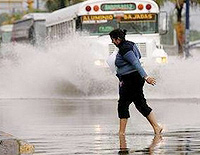
Huge mudslides, flooding and torrential rains from Hurricane Stan have killed at least 133 people in Central America and southern Mexico, rescue workers said on Wednesday.
Relentless rain pounded mountain villages and urban shanty towns across the impoverished region, and hillsides collapsed under four days of downpours.
The death toll nearly doubled on Wednesday when rivers burst their banks in southern Mexico, and emergency teams found another 42 people buried under several feet of mud in remote Guatemalan towns.
The government said the death toll would rise and unconfirmed reports said hundreds may have been killed in an isolated region of western Guatemala.
Entire families were missing after a river of mud, trees and rocks descended on the hill town of Tecpan, west of the capital, destroying more than 30 flimsy homes.
"A lot of people could not get out," said Samuel Cif, a local peasant.
Two dead children were found and villagers were too scared of more landslides to dig for other victims.
Clothes, trees and the roofs were strewn around and heavy rain still pounded the area.
The tragedy brought back memories of Hurricane Mitch, which killed some 10,000 people in 1998 in Central America, mainly in Honduras and Nicaragua, with mudslides and flooding.
Stan dumped about half the amount of water on Guatemala in five days that Mitch deposited in only three days, meteorologists said.
Heard cries
"I was like a worm sliding around in the mud," said Alexander Flores, whose home on the edge of San Salvador was buried under six feet of dirt and rocks.
"I just heard two shouts from my mother, saying, 'Alex, Alex,' maybe for me to help her or her trying to save me," he said. His mother and five children, including a newborn baby, all died, he said.
Sixty-two people have now been killed in El Salvador, 50 in Guatemala, and another 21 total in Mexico, Nicaragua and Honduras, authorities said.
Coffee production was likely to be hit in Guatemala and Honduras just as the harvest is beginning, producers said.
Swollen rivers washed away three large concrete bridges and ripped apart houses and buildings when they burst their banks at the city of Tapachula, in Mexico's Chiapas state.
"My house was here," said Rosenberg Arias, a doctor pointing into the Coatan River. "And that was my grandmother's house, and that was my neighbor's house. Now there is nothing," he said, signaling into the angry waters.
Looters wandered into a damaged hotel and carried away office equipment and radios. Tree trunks lay beside cars, a refrigerator and dead fish by the riverside.
Tens of thousands of people fled their homes in Chiapas and the neighboring state of Veracruz after Stan, now reduced to a tropical depression, swept in from the Atlantic this week.
It came ashore on Tuesday near the city of Veracruz as a Category One hurricane with winds of nearly 80 mph (128 kph).
"There is flooding, in some communities mudslides; there is no access by road, no telephone communication," said Jordan Jimenez of Mexico's civil protection agency in Chiapas. "There are people missing, some in shelters."
Greenpeace said the flooding in Mexico was made worse by deforestation, as water rushed down bare hillsides.
"Once again, this underlines the importance of conserving eco-systems, particularly forests and mangroves, to prevent the impact of hurricanes," the environmentalist group said.
Mexico's three main oil exporting ports, on the Gulf of Mexico, reopened after closing as Stan approached.
(Chinadaily.com via agencies October 6, 2005)
|

